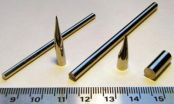(Press-News.org) CORAL GABLES, FL (January 12, 2011) --Living through a natural disaster is a traumatic experience for everyone, but especially for children. A new study by University of Miami Psychologist Annette La Greca and her collaborators, indicate that some children who directly experience a devastating hurricane still show signs of posttraumatic stress (PTS) almmost two years after the event. The findings suggest that new models for intervention to help children after a natural disaster are needed.
The study, titled "Hurricane-Related Exposure Experiences and Stressors, Other Life Events, and Social Support: Concurrent and Prospective Impact on Children's Persistent Posttraumatic Stress Symptoms," is published online in the Journal of Consulting and Clinical Psychology and will be in print in the December 2010 issue.
Previous research mainly has focused on children during the few months after a major hurricane, or two years or more after the event. Most of the existing post-hurricane interventions are designed for children experiencing PTS two years or more after the storm. The new study "picks up where others left off," assessing children during the in-between period, at nine months (Time One) and then at 21 months after a hurricane (Time Two), explains La Greca, professor of Psychology and Pediatrics in the college of Arts and Sciences at UM and principal investigator of the study.
"There have been no tested interventions developed for children who still show significant symptoms of PTS almost a year after a devastating hurricane," says La Greca. "What this study shows is that there may be a need to test intervention programs to be used from several months to two years post-disaster, to keep kids from developing persistent stress."
The researchers studied 384 children, in second to fourth grade that lived through Hurricane Charley, a strong category four hurricane that struck Charlotte County, in Southwest Florida in 2004. The storm caused 35 deaths, extensive damage of more than $16.3 billion and prolonged school closures.
According to the study, 35 percent of the children reported moderate to very severe levels of PTS at Time One, and 29 percent were still reporting these levels of stress at Time Two. Although previous studies have shown that children stress symptoms decline the first year after the hurricane, this study shows that children who are still showing signs of stress towards the end of the first year are likely to persist having symptoms another year later.
"It's more common than not for most children to overcome, on their own, the effects of exposure to a severe hurricane," says Wendy Silverman,professor of Psychology and Director of the Child Anxiety and Phobia Program at FIU.
Florida International University (FIU) and co-author of this study. Our findings that posttraumatic stress symptoms continued in such a high percentage of children almost two years after Hurricane Charley were somewhat unexpected."
The symptoms the children experience range from reoccurring dreams about the hurricane, to being tense, more distracted, feeling like nobody understands them, more difficulty sleeping, and feeling more sad or fearful than before the disaster. In addition to experiences directly related to the hurricane, other events in the life of a child during the recovery period, such as parents' separation or an illness in the family, have a "cascading effect" that magnifies the child's difficulties
"Finding that hurricane related stressors could contribute to other major life events was not necessarily counterintuitive, but, as far as I know, not documented before, and from that perspective, is a significant finding," says Silverman.
Interestingly, social support from peers was found to be very important in helping to protect the child from the psychological impact of the hurricane. "For children that have experienced a destructive hurricane, restoring contact with friends provides a buffer to the negative experiences, helping kids have greater resilience and to adjust better to life after the disaster," says La Greca.
INFORMATION:
The researchers would like their study to have an impact on public policy so that better mechanisms are developed to help get kids back on the right track. Other scientists involved in this study include Betty Lai, a graduate student at the UM Department of Psychology, who is currently a clinical intern at Packard Children's Hospital at Stanford University and James Jaccard, professor of Psychology at FIU.
The University of Miami's mission is to educate and nurture students, to create knowledge, and to provide service to our community and beyond. Committed to excellence and proud of the diversity of our University family, we strive to develop future leaders of our nation and the world. www.miami.edu
EUGENE, Ore. -- (Jan. 12, 2011) -- As adolescents move from elementary school into their middle or junior-high years, changes in friendships may signal potential academic success or troubles down the road, say University of Oregon researchers.
A new study, appearing in the February issue of the Journal of Early Adolescence, found that boys and girls whose friends are socially active in ways where rules are respected do better in their classroom work. Having friends who engage in problem behavior, in contrast, is related to a decrease in their grades. Having pro-social ...
Scientists from Texas have made an important step toward understanding human mating behavior by showing that certain genes become activated in fruit flies when they interact with the opposite sex. This research, published in the January 2011 issue of the journal GENETICS (http://www.genetics.org), shows that courtship behaviors may be far more influenced by genetics than previously thought. In addition, understanding why and how these genes become activated within social contexts may also lead to insight into disorders such as autism.
"Be careful who you interact with," ...
PASADENA, Calif.—Glass is inherently strong, but when it cracks or otherwise fails, it proves brittle, shattering almost immediately. Steel and other metal alloys tend to be tough—they resist shattering—but are also relatively weak; they permanently deform and fail easily.
The ideal material, says Marios Demetriou, a senior research fellow at the California Institute of Technology (Caltech), has the advantage of being both strong and tough—a combination called damage tolerance, which is more difficult to come by than the layperson might think. "Strength and toughness ...
MOUNTAIN VIEW, CA – January 11, 2011 – 23andMe has released its first annual list of what it felt to be the 10 most interesting and significant genetic findings in 2010, as part of an ongoing journey to understand the role of genetics in personal health and human development.
"Our understanding of the human genome is accelerating at a phenomenal rate," stated Anne Wojcicki, co-founder and CEO of 23andMe. "Below we have compiled a list of our top ten favorite genetic discoveries from 2010. We look forward to exploring more discoveries in 2011."
Customers of 23andMe ...
Grand Rapids, Mich. (January 12, 2011) – Van Andel Research Institute (VARI) researchers have developed a method that can yield more information from archived newborn blood that has implications for a vast array of research, including population health studies and answering questions about diseases in infants and children.
In a recent study published in Pathology International, VARI researchers detected approximately 9,000 activated genes in samples from adult blood spots on Guthrie cards that had been archived anywhere from six months to three years. Researchers say ...
Nature has a bit of a Jekyll and Hyde relationship with mercury, but researchers at the Department of Energy's Oak Ridge National Laboratory have made a discovery that ultimately could help explain the split personality.
While scientists have known that microbes in aquatic environments make methylmercury, a more toxic form of mercury that accumulates in fish, they also know that nature and other types of bacteria can transform methylmercury to less toxic forms. What they haven't completely understood are the mechanisms that cause these transformations in anoxic environments ...
This press release is available in French.
Robot-assisted surgery dramatically improves outcomes in patients with uterine, endometrial, and cervical cancer, said researchers at the Jewish General Hospital's Lady Davis Institute for Medical Research in Montreal. Moreover, because of fewer post-operative complications and shorter hospital stays, robotic procedures also cost less.
These results were published in late 2010 in a series of studies in The Journal of Robotic Surgery and The International Journal of Gynecological Cancer.
To date, adoption of robotic surgery ...
RIVERSIDE, Calif. — Bahram Mobasher, a professor of physics and astronomy at the University of California, Riverside, is a member of an international team of astronomers that has uncovered a burgeoning galactic metropolis, the most distant known in the early universe. This ancient collection of galaxies presumably grew into a modern galaxy cluster similar to the massive ones seen today.
The developing cluster, named COSMOS-AzTEC3, was discovered and characterized by multi-wavelength telescopes, including NASA's Spitzer, Chandra and Hubble space telescopes, and the ground-based ...
Using two NASA X-ray satellites, astronomers have discovered what drives the "heartbeats" seen in the light from an unusual black hole system. These results give new insight into the ways that black holes can regulate their intake and severely curtail their growth.
This study examined GRS 1915+105 (GRS 1915 for short), a binary system in the Milky Way galaxy containing a black hole about 14 times more massive than the Sun that is feeding off material from a companion star. As this material falls towards the black hole, it forms a swirling disk that emits X-rays. The black ...
In the first update of the American Geriatrics Society and the British Geriatric Society's guidelines on preventing falls in older persons since 2001, they now recommend that all interventions for preventing falls should include an exercise component and that a number of new assessments should be used, including; feet and footwear, fear of falling, and ability to carry out daily living activities. The guidelines, a summary of which are published today in the Journal of the American Geriatrics Society, also state that fall screening and prevention should be a part of all ...




